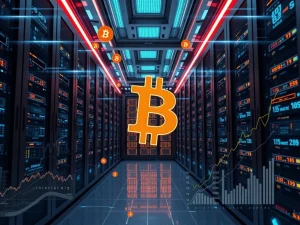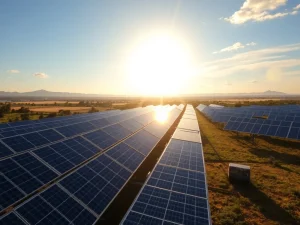Revolutionary Bitcoin Mining Japan Project Boosts Electric Grid Stability

The cryptocurrency world often discusses innovation. Now, a groundbreaking development in Bitcoin Mining Japan is set to redefine energy management. Canaan, a leading producer of mining hardware, has secured a significant contract. This agreement involves supplying advanced Bitcoin mining rigs for a crucial project in Japan. The initiative aims to enhance the nation’s electric grid stability. It represents a practical application of crypto technology in traditional infrastructure. This move highlights Bitcoin mining’s evolving role beyond mere coin generation. Instead, it positions mining as a vital tool for energy optimization and grid resilience.
Bitcoin Mining Japan: A New Era for Grid Stability
Japan faces unique challenges with its electric grid. Fluctuating energy demands and growing renewable energy sources require innovative solutions. Therefore, an electrical engineering solutions provider in Japan has partnered with Canaan. This partnership focuses on deploying 4.5 megawatts (MW) of specialized Bitcoin mining ASICs. These powerful machines will contribute to real-time grid balancing. They will also improve overall energy efficiency. This project marks a significant step forward. It demonstrates how digital assets can support critical national infrastructure. It also underscores Japan’s commitment to adopting advanced technologies for sustainable development.
Grid load balancing is essential for modern power systems. It involves continuously matching electricity supply with demand. This process ensures frequency and voltage remain within safe operating limits. Energy consumption and renewable output often fluctuate significantly. Without proper management, these variations can lead to price spikes. They can also cause potential outages. Bitcoin mining offers a unique solution to this problem. It acts as a fast, controllable demand response mechanism. Miners can strategically locate near renewable energy installations. There, they can absorb surplus power. They can also shut down quickly when grid demand tightens. This flexibility makes Bitcoin mining a valuable asset for grid operators.
Canaan Mining Rigs Powering Innovation
Canaan’s involvement in this project is pivotal. The company will supply its new Canaan Mining Rigs, specifically the Avalon A1566HA-488T model. These are advanced water-cooled Bitcoin mining ASICs. Water-cooling technology offers superior efficiency and stability. This is crucial for operations requiring dynamic power adjustments. The rigs will operate continuously. They will utilize controlled overclocking and underclocking. This allows for precise adjustments in power consumption. Such flexibility is key to stabilizing regional grid loads effectively.
Furthermore, Canaan’s proprietary control systems will play a vital role. These systems dynamically adjust frequency, voltage, and hashrate. They ensure the mining operation perfectly matches power supply and demand. Nangeng Zhang, Canaan’s chairman and CEO, highlighted this capability. He stated that machines equipped with this system allow utilities to leverage Bitcoin mining. It acts as a digital load balancer. This improves both energy sustainability and grid efficiency. This project builds upon similar successful initiatives. For instance, Canaan supported a comparable project in the Netherlands last year. These precedents underscore the proven effectiveness of this approach.
Achieving Electric Grid Stability with Dynamic Loads
The core concept behind this project is using Bitcoin mining for Electric Grid Stability. Traditional grids struggle with unpredictable energy sources. Solar and wind power generate electricity intermittently. This creates challenges for maintaining a steady supply. Conversely, electricity demand also varies throughout the day. Peak hours require more power, while off-peak times see surpluses. This imbalance can strain the grid. It can also lead to wasted energy.
Bitcoin mining provides a flexible, interruptible load. It can quickly scale up or down its power consumption. This makes it an ideal partner for renewable energy sources. When wind farms produce excess power, miners can ramp up operations. They consume this surplus energy. When the grid needs power elsewhere, miners can scale back instantly. This capability helps prevent curtailment of renewable energy. It also stabilizes grid frequency and voltage. Essentially, Bitcoin miners act as large, responsive batteries. They absorb excess power and release grid capacity when needed. This dynamic response mechanism is crucial for modernizing energy infrastructure.
Key Benefits for Grid Stability:
- Demand Response: Miners can quickly adjust power consumption. This helps balance supply and demand in real-time.
- Renewable Energy Integration: They absorb surplus energy from intermittent sources. This reduces waste and increases renewable utilization.
- Grid Resilience: By providing a flexible load, miners prevent overloads and potential outages.
- Economic Efficiency: Utilities can monetize excess power. This avoids costly infrastructure upgrades like new peaker plants.
Energy Optimization Through Bitcoin as Load Balancer
The project’s success hinges on effective Energy Optimization. This involves maximizing the use of available energy resources. It also minimizes waste. Bitcoin mining facilities, by their nature, consume significant power. However, when integrated intelligently, they become assets. They transform from simple consumers to active participants in energy management. This paradigm shift is gaining global recognition. Companies are exploring how to leverage mining’s unique characteristics.
Consider the example of Brazil. Thopen, a Brazilian solar power producer, is exploring Bitcoin mining. They aim to absorb surplus energy from the country’s fast-growing renewable sector. This demonstrates a global trend. Energy producers are recognizing mining’s potential. They see it as a way to make their operations more sustainable and profitable. Similarly, a January report by the Digital Assets Research Institute highlighted Bitcoin mining’s impact on the Texas electrical grid. The report suggested mining saved the state as much as $1.8 billion. It did so by eliminating the need for new gas peaker plants. These examples underscore the economic and environmental benefits of this approach.
Ultimately, Bitcoin mining acts as a valuable Bitcoin as Load Balancer. It provides a controllable, flexible load. This load can be turned on or off almost instantly. This capability is far superior to traditional industrial loads. Factories often require significant ramp-up and cool-down times. Bitcoin mining rigs, however, offer immediate responsiveness. This makes them ideal for mitigating the volatility of renewable energy generation. They provide a stable, predictable demand. This allows grid operators to manage their networks more efficiently. Consequently, it leads to a more robust and sustainable energy ecosystem.
Global Precedents and the Future of Bitcoin Mining Energy
The project in Japan is not an isolated incident. It builds on a growing global trend. More regions are recognizing the symbiotic relationship between Bitcoin mining and energy infrastructure. As mentioned, Canaan supported a similar initiative in the Netherlands. These projects validate the concept. They prove that crypto mining can be a powerful tool for modernizing energy grids. They also demonstrate a pathway for integrating more renewable energy sources effectively.
The future of Bitcoin Mining Energy appears increasingly intertwined with sustainable energy practices. As the world transitions to cleaner energy, flexible demand response becomes crucial. Bitcoin mining offers a scalable and efficient solution. It can help balance intermittent renewable energy. This includes solar, wind, and even hydroelectric power. By providing a constant, adjustable demand, miners ensure these valuable resources are not wasted. Instead, they are utilized to their full potential. This fosters a more resilient and environmentally friendly energy future.
In conclusion, Canaan’s partnership in Japan represents a significant milestone. It showcases the practical benefits of Bitcoin mining beyond digital currency. This innovative project will bolster Japan’s electric grid stability. It will also serve as a model for other nations. By leveraging advanced mining technology, countries can achieve greater energy efficiency. They can also accelerate the integration of renewable energy. This makes the electric grid more resilient. Ultimately, it paves the way for a sustainable energy future powered by intelligent demand management.









